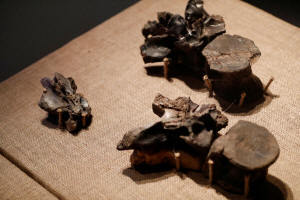|
The dinosaur, a new species named Maip macrothorax, was between
nine and 10 meters (29.5 and 32.8 feet) long, while other "megaraptors"
were no longer than nine meters, said one of the scientists who
participated in the discovery, Mauro Aranciaga Rolando.
"This animal is very large in size and we were able to recover a
lot of remains," Aranciaga Rolando told Reuters on Wednesday,
when the fossils were shown at the Bernardino Rivadavia Natural
Sciences Argentine Museum in capital Buenos Aires.
The fossils were discovered in March 2019 in the Patagonian
province of Santa Cruz, days before strict COVID-19 pandemic
restrictions were enforced, said the National Scientific and
Technical Research Council, to which the experts who found the
dinosaur belong.
Two Japanese scientists also participated in the Argentine
expedition.
Due to the pandemic, paleontologists initially had to distribute
the fossils between them and analyze them at home.
The carnivorous dinosaur is thought to have inhabited what is
now the southern tip of Argentina 70 million years ago during
the Cretaceous period.
Megaraptors were animals with an agile skeleton, a long tail
that allowed them to maneuver and balance, a long neck and an
elongated skull with more than 60 small teeth, said Aranciaga
Rolando, who explained that the sharp-ended limbs of "Maip" were
the animal's most dangerous weapon.
(Reporting by Miguel Lo Bianco; Writing by Steven Grattan;
Editing by Sandra Maler)
[© 2022 Thomson Reuters. All rights
reserved.]
This material may not be published,
broadcast, rewritten or redistributed.
Thompson Reuters is solely responsible for this content.

|
|




